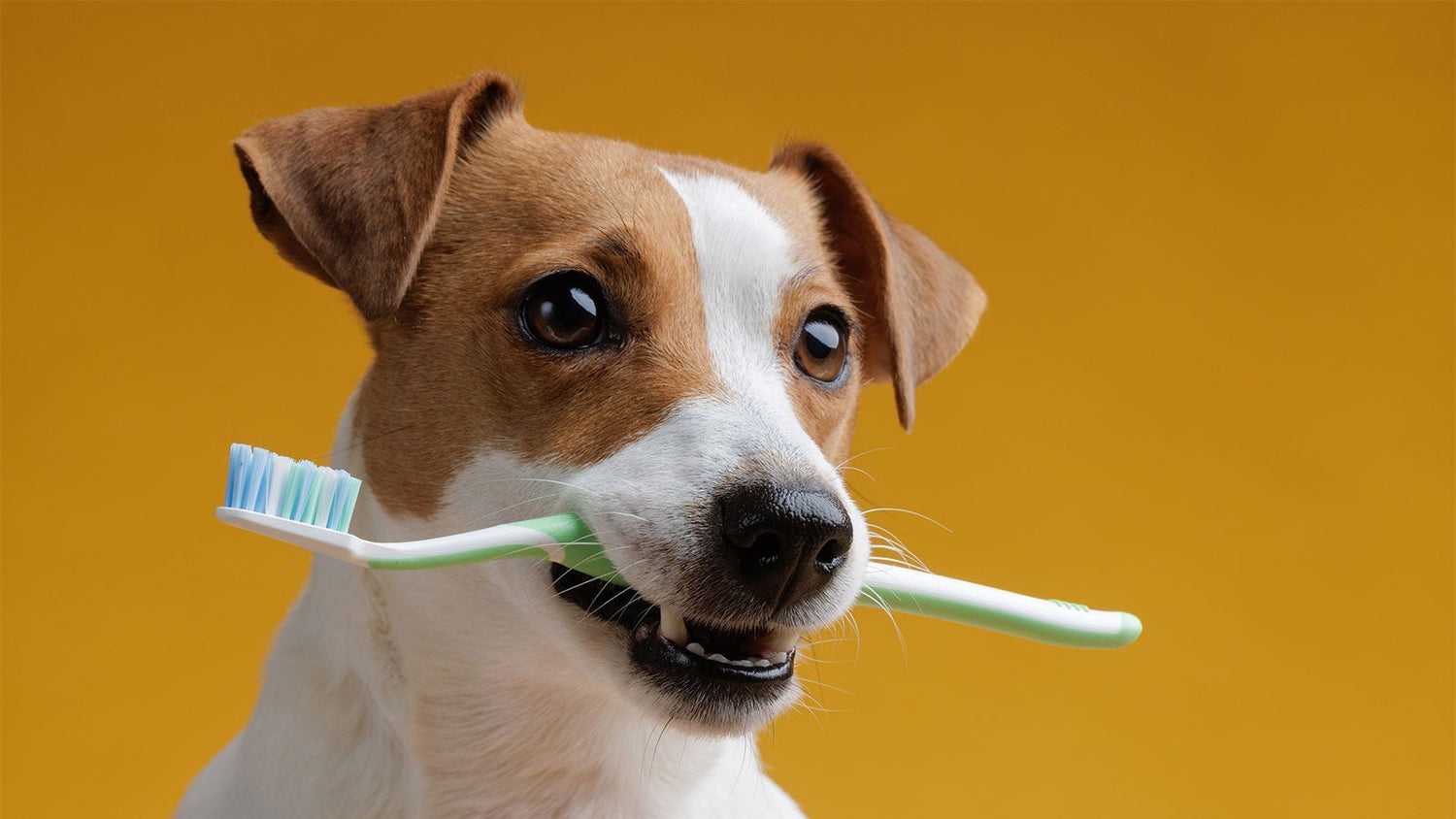This article is contributed by Esther Lim, pawrent to 2 lovely dogs named Milo (@babymiloxpoodle) and Maya (@mayaxgoldendoodle). Esther believes that a combination of both physical and mental stimulation is key to happy, healthy dogs. Her dogs own a few Trixie strategy puzzles and Starmark Treat Dispensing Tetraflex ball.
You might have heard the complaints "my puppy is chewing my stuff" or "my dog is destroying the furniture". Very few people take the time to ask and understand why, and most assume it's because the dog is just being naughty. The truth is, no dog is born naughty. Dogs tend to resort to this unwanted behaviour due to being bored or not stimulated enough. Dogs need an outlet for their minds, and if they aren't provided with a "job", chances are they will come up with their own. Physical exercise is excellent and necessary for a dog, but it is only half of the equation. Dogs are highly intelligent creatures and require mental exercise. If you have a mentally stimulating day where your brain really gets a workout, you are usually exhausted by the end of the day. If you don't have any mental stimulation, you naturally have more energy. The same holds true with your dog.
Dogs are born to sniff. The smell is a dog's primary sense, and like our eyes for us, their noses deliver the most vivid detail about the world? The area of the canine brain that is devoted to analyzing scent is 40 times greater than that of the human, and dogs can identify smells at least 1,000 times better than we can. In fact, one-eighth of a dog's brain is dedicated to interpreting odour. The ability of the dog to detect scents varies between breeds, with long-nosed dogs able to distinguish smells better than the short-faced ones. Sniffing gives dogs mental stimulation. Dogs' sense of smell is crucial for communicating, exploring, and evaluating. Some dogs can become over-stimulated when they do high energy level activities, but harnessing your dog's natural sniffing behaviour is a calm and relaxing option. Providing your dog with ample sniffing opportunities can make your dog feel more optimistic. Dog brains are designed to sniff their way through the world. Letting your dog gather information in the form of smell is vital for their mental wellbeing.
Dogs do get bored. Research has shown that undesirable behaviour such as excessive barking, peeing and pooping around the house and destroying their toys usually go away when owners start to give their dogs mentally stimulating activities to keep them happy, calm and relaxed. Not only is mental stimulation great for your dog's health, but it also helps strengthen the bond between you and your pet. If you have a highly intelligent dog, it is even more important to keep your dog entertained. Especially if you have a working-breed, who doesn't have a "job" to do. Even dogs can get "cabin fever". If you work long hours and your dog spends all of their time at home, they get bored quickly. Dogs are naturally curious creatures and crave new smells, sights, and experiences. Dogs that are not mentally stimulated can show signs of being unhappy, such as peeing and pooping around the house, destroying furniture, so on. Giving them a snuffle mat or a puzzle toy allows them to expend their mental energy through problem-solving. It can also prevent unwanted behaviour by channelling their energy into something positive. Consider challenging activities that can build their brainpower and help beat boredom, like hiding treats in a puzzle toy, so your dog has to work to get the treat. Trixie dog toys like their strategy games require the dog to lift lids, open drawers, or move blocks to expose hidden food and stretch their intellectual muscle at the same time.
Dogs love challenges. Feed your dog with a wobbler or puzzle feeder instead of a regular dog bowl. This technique helps reduce stress-related behaviours and can even get the pickiest dog to start eating. Working to get a meal is something dogs were born to do. Tearing things apart is a dog's basic instinct, so when a dog gets it out of the system by digging his meals out from a food dispenser, it will feel less need to shred the furniture. Working for his meals increases its value, as he now "earns" it. Puzzle feeder or food dispensing toys also prevents your pet from gulping and swallowing down their meals that may cause deadly canine bloat. A snuffle mat is a brain game with fleece strips and helps dogs use and sharpen their sense of smell and hunting skills. The Studio Ollie Snuffle Bag can be unzipped and laid flat like a snuffle mat. It is specifically designed to help and "make" your dog look for food by sniffing and foraging. Snuffle mats mimic grass, fields, and outdoor areas and encourage food foraging in dogs. The act of working for and seeking out food is not only satisfying to dogs; it is a fundamental need that allows them to fulfil their hunting needs. Snuffle mats and puzzle toys are also excellent activities for less mobile dogs on restricted exercise after surgery. It can also be a helpful tool for helping nervous dogs feel more relaxed and confident. It is a good idea to get several puzzle styles so that your dog doesn't get bored and lose interest quickly. Make sure to choose a difficulty level suitable for your pet, as different dogs have different skills, experience, and motivation levels. Foraging needs to be challenging and varied enough to maintain a dog's interest. It should be fun and not be so complex that they give up or don't even try.
"When will I see you again?" is what a dog with separation anxiety "sings" when that front door closes. Dogs are social creatures, and they need you to survive, so naturally, your dog has a small panic attack when left to fend for himself at home. Some dogs bark, howl, some resort to attempting escape, and some separation anxiety are so extreme, it can result in self-inflicted injury. When treating a dog with separation anxiety, the goal is to resolve the dog's underlying anxiety by teaching him to enjoy, or at least tolerate, being left alone. Treat dispensing toys like our Starmark Treat Dispensing Bob-a-lot is guaranteed to keep your dog very busy and entertained as it releases food or treats as your dog paws, nudges and chases it. Starmark dog toys help ward off separation anxiety by keeping them occupied, and at the same time, it also provides an appropriate outlet for mental energy. It lowers their stress levels by creating a positive association with you leaving the house.
When you are at home with your dog, the Starmark Treat Dispensing Tetraflex teaches dogs to choose distance away from their owners. Especially for dogs who tend to be glued to the pawrent and will not ever walk too far away. The Tetraflex ball rolls and dispenses a meal or treats when nudged; hence, the dog controls and decides the distance to suit his comfort level, building up his confidence level. If the toy rolls too far from the owner for the dog's comfort, he can pick it up easily and bring it back to the original location. Many dogs go absolutely wild for these toys and, in time, start to choose to let them roll farther and farther away, even out of sight, into another room.
Having a dog is one of the best things in the world, but it isn't without its downsides. One of the worst aspects is watching them age relatively quickly. As dogs age, they face many of the same challenges that we humans face, including cognitive decline. Like humans, a dog's brain literally shrinks the older the dog becomes. Dog dementia, also known as Canine Cognitive Dysfunction (CCD), is a cognitive disorder in dogs associated with effects similar to those of Alzheimer's in humans. It's a condition related to the ageing of a dog's brain, which leads to changes in behaviour and primarily affects memory, learning and comprehension. A decline in thinking skills often affects dogs older than 8 years old. Signs of canine mental decline include:
- disorientation and confusion
- anxiety
- changes in sleep/wake cycles
- housetraining accidents
- less desire for physical activity and social interaction
Dogs with memory loss may have forgotten routine commands such as "sit" and "stay". Through research, we have learned that we can slow the ageing process by keeping your dog physically and mentally active and may help to prevent dementia. Studies have shown that mental games and problem-solving activities help wake up areas of the brain that have been inactive, keeping it sharp and protecting it against further decline. Like elderly people doing the morning crossword to stay alert, giving your senior dog daily puzzles will keep their minds stimulated. Combining sight, scent, and spatial orientation required to solve puzzles can help connect different parts of the brain.
And of course, any type of play with you, their favourite person, is stimulation enough to get their neurons firing. Their senses may not be quite as sharp as they once were, and they may not move as quickly, but having fun with their people is still a thrill. Playtime with your seniors will not only up the quality of your relationship but also keep their brains happy and healthy.
A mentally stimulated dog is a happy dog! Do not wait until your pet starts showing signs of dementia to introduce brain training. Mental stimulation benefits dogs of all ages. Take the time to make sure your dog has enough mental exercise, and be sure to switch up the mind games to keep everything feeling new and fresh. The more you exercise your dog's brain, the happier and calmer it will be.
All views expressed on this site are author's own and do not represent the opinions of any entity whatsoever. The purpose of the article is to share experiences and opinions in general. If you are seeking professional advice, please consult a professional.





